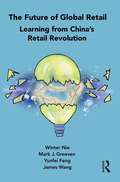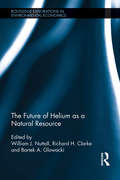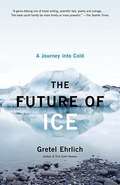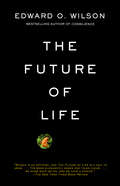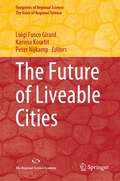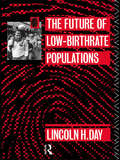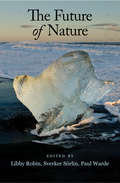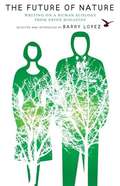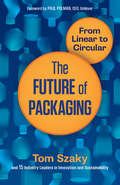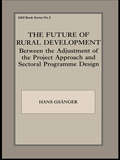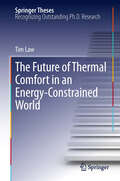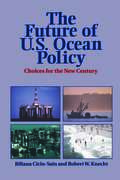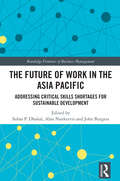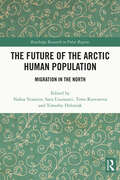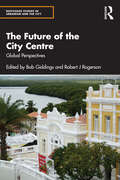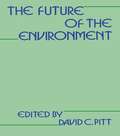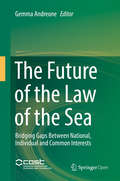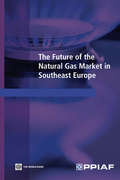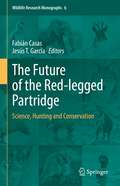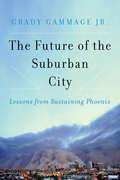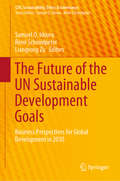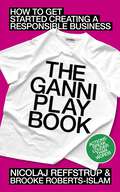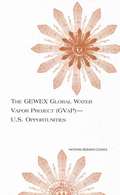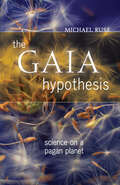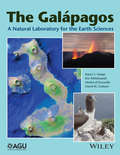- Table View
- List View
The Future of Global Retail: Learning from China's Retail Revolution
by James Wang Winter Nie Mark J. Greeven Yunfei FengChina’s new retail revolution will completely transform how the world thinks about retail and digital innovation. But is the world ready yet? In this book, the authors share an insider’s perspective on what is happening in China to reveal the future for global retail, and a clear framework to help you prepare. The book presents a number of real-world cases, based on interviews and first-hand consumer experience, to decode China’s retail revolution so that you can understand what is happening and why, and what it means for the rest of the world. Crucially, the book identifies five critical stages in the development of new retail that global retail executives need to grasp now: lifestyle commerce, Online-Merge-Offline retail, social retail, livestream retail and invisible retail. To help the industry get ready for this new, China-inspired paradigm in retail, the authors present a practical and simple framework – a ten-year strategic roadmap for global retail executives, which we call the “Beyond” the Value Chain Model. China’s new retail is not just about fashion, cosmetics, snacks, data-driven convenient stores and commercial live streaming. At a time when the world of retail is being upended, it offers inspirational lessons in innovation, purpose and agility for global executives across the entire retail spectrum.
The Future of Helium as a Natural Resource (Routledge Explorations In Environmental Economics Ser.)
by William J. Nuttall Richard H. Clarke Bartek A. GlowackiThe book reveals the changing dynamics of the helium industry on both the supply-side and the demand-side. The helium industry has a long-term future and this important gas will have a role to play for many decades to come. Major new users of helium are expected to enter the market, especially in nuclear energy (both fission and fusion). Prices and volumes supplied and expected to rise and this will prompt greater efforts towards the development of new helium sources and helium conservation and recycling.
The Future of Ice: A Journey into Cold
by Gretel EhrlichTo understand the complex, primal nature of cold, Ehrlich traveled to extreme points, from Tierra del Fuego to the Arctic circle. In this volume she reports on her experiences of the many expressions of cold--wind, water, snow and ice--and describes the history of these elements and of ocean currents and weather cycles. She attempts to uncover through her experiences the quintessential connection between humans and the physical world. Annotation ©2004 Book News, Inc. , Portland, OR (booknews. com)
The Future of Life
by Edward O. WilsonOne of the world’s most important scientists, Edward O. Wilson is also an abundantly talented writer who has twice won the Pulitzer Prize. In this, his most personal and timely book to date, he assesses the precarious state of our environment, examining the mass extinctions occurring in our time and the natural treasures we are about to lose forever. Yet, rather than eschewing doomsday prophesies, he spells out a specific plan to save our world while there is still time. His vision is a hopeful one, as economically sound as it is environmentally necessary. Eloquent, practical and wise, this book should be read and studied by anyone concerned with the fate of the natural world.
The Future of Liveable Cities (Footprints of Regional Science)
by Peter Nijkamp Karima Kourtit Luigi Fusco GirardThis book explores the concept of livable cities, where people enjoy living and being, and examines indicators of citizens' well-being in relation to the urban environment. It is authored by experts from diverse disciplines, providing a citizen-centered perspective on urban well-being in sustainable, environmentally friendly, and climate-neutral (or -positive) cities. The contributions focus on the human and social aspects of cities, developing operational models and frameworks for circular cities, smart resource utilization, and examining contextual factors such as environmental and neighborhood quality, energy transition, climate neutrality, and recycling as factors that influence the well-being of "homo urbanus.” The chapters approach these topics from various analytical perspectives, including conceptual/theoretical, methodological/modeling, policy/planning, and evidence-based case studies. This book will be of interest to scholars in regional and spatial science, urban geography, economics, and related fields, as well as those interested in urban well-being.
The Future of Low Birth-Rate Populations
by Lincoln H. DayFirst Published in 2004. Routledge is an imprint of Taylor & Francis, an informa company.
The Future of Nature
by Paul Warde Sverker Sorlin Libby RobinThis anthology provides a comprehensive overview of the science behind environmental prediction and how, as predictions about environmental change have been taken more seriously and widely, they have affected politics, policy, and public perception. Through an array of texts and commentaries that examine the themes of progress, population, environment, biodiversity, and sustainability from a fully global perspective, it shows how twenty-first century predictors think about what forecasting the future means. Providing access and reference points to the origins and development of key disciplines and methods, it will encourage policy makers, professionals, and students to reflect on the roots of their own theories and practices.
The Future of Nature: Writing on a Human Ecology from Orion Magazine
by Barry LopezThe western mindset is arguably one of the greatest threats to the world's ecological balance. Corporatism and globalization are two of the obvious villains here, but what part does human nature play in the problem? Since its inception in 1982, "Orion" Magazine has been a forum for looking beyond the effects of ecological crises to their root causes in human culture. Less an anthology than a vision statement, this timely collection challenges the division of human society from the natural world that has often characterized traditional environmentalism. Edited and introduced by Barry Lopez, "The Future of Nature" encompasses such topics as local economies, the social dynamics of activism, America's incarceration society, naturalism in higher education, developing nations, spiritual ecology, the military-industrial landscape, and the persistent tyranny of wilderness designation. Featuring the fine writing and insights for which "Orion" is famous, this book is required reading for anyone interested in a livable future for the planet.
The Future of Packaging: From Linear to Circular
by Tom SzakyOutstanding Book of the Year gold medalist and "Most Likely to Save the Planet" from the Independent Book Publisher Awards.Tom Szaky sets out to do the impossible – eliminate all waste. This book paints a future of a "circular economy" that relies on responsible reuse and recycling to propel the world towards eradicating overconsumption and waste. Only 35 percent of the 240 million metric tons of waste generated in the United States alone gets recycled, according to the Environmental Protection Agency. This extraordinary collection shows how manufacturers can move from a one-way take-make-waste economy that is burying the world in waste to a circular, make-use-recycle economy. Steered by Tom Szaky, recycling pioneer, eco-capitalist, and founder and CEO of TerraCycle, each chapter is coauthored by an expert in his or her field. From the distinct perspectives of government leaders, consumer packaged goods companies, waste management firms, and more, the book explores current issues of production and consumption, practical steps for improving packaging and reducing waste today, and big ideas and concepts that can be carried forward.Intended to help every business from a small start-up to a large established consumer product company, this book serves as a source of knowledge and inspiration. The message from these pioneers is not to scale back but to innovate upward. They offer nothing less than a guide to designing ourselves out of waste and into abundance.
The Future of Rural Development: Between the Adjustment of the Project Approach and Sectoral Programme Desig
by Hans GsangerThis book gives a practitioner's account of international experiences with rural development seen from a German angle. It argues for a development co-operation for rural areas that actively supports popular participation, beneficiaries' self-organization, decentralization and, consequently, smaller self-managed (para)projects rather than large, top-down organized rural development projects.
The Future of Thermal Comfort in an Energy- Constrained World
by Tim LawThe dissertation investigates the scientific and business factors that have resulted in air-conditioning being a major contributor to climate-change. With his architectural background, the author demonstrates how a design methodology, not commonly adopted in scientific studies, may actually be a suitable way of dealing with a complex problem: the 'business as usual' scenario involving building science, sociological values and consumer behavior. Using his innovations as case studies, the author shows how good ideas cannot be evaluated on scientific merit alone and demonstrates why commercialization may have a pivotal role in deployment of research-based technology. He advances the theory of personalized thermal comfort which can potentially resolve the air-conditioning conundrum.
The Future of U.S. Ocean Policy: Choices For The New Century
by Robert Knecht Biliana Cicin-SainThe United States is about to embark on the most thorough reconsideration of its ocean policy in more than three decades. With 1998 designated as the International Year of the Ocean by the United Nations, and with both the executive branch and the Congress currently working toward developing new approaches to formulating and implementing ocean policy, a comprehensive overview of key issues and concerns is essential.The Future of U.S. Ocean Policy provides such an overview, with an in-depth analysis of the evolution of U.S. ocean policy and a timely discussion of the most important ocean and coastal issues facing the nation. The book assesses the current status of ocean policy, examines national and international trends, and considers choices for policymakers in the 21st century. Following an introductory chapter that reviews national ocean policy and the process by which it is made, the authors: review the history of development of U.S. ocean and coastal policy examine the major ocean laws enacted in the 1970s and review and assess their record of implementation examine factors that will affect U.S. ocean policy in the coming decade discuss the need to make policy more coherent, and to develop institutional mechanisms that can foster more effective guidance and oversight present a set of policy options for improving U.S. ocean policyThe Future of U.S. Ocean Policy is the only recent book that focuses on national ocean policy in its entirety, and will play an important role in upcoming debates concerning the future direction of policy initiatives. Agency personnel, members and staff of nongovernmental organizations, industry groups, Congressional staffers, state and local government officials, academics, and concerned citizens will find the book an invaluable guide, as will students and faculty in courses in marine and coastal management and in environmental management.
The Future of Work in the Asia Pacific: Addressing Critical Skills Shortages for Sustainable Development (Routledge Frontiers of Business Management)
by John Burgess Alan Nankervis Subas P. DhakalBringing together informed analyses on the challenges of critical skill shortages (CSS) in the Asia-Pacific region, this book provides 14 country reports to discuss the critical jobs and skills to achieve long-term policies and approaches towards realising the United Nations sustainable development goals (SDGs).The contributors of the volume discuss the workforce projections and planning, existing programmes that address the skills and jobs needed, and workforce policy challenges that need to be addressed to achieve the SDGs. The book identifies two types of CSS present in the workforce: one being skilled labour shortages in existing industries and the second being soft skills like critical thinking and problem-solving skills. Extending the discussion beyond immediate skill shortages, the book assesses longer-term policies and approaches to tackle the 2030 United Nations Agenda for Sustainable Development.This book will interest researchers in the fields of human resource management and development, international business, development studies, and policymakers from the Asia-Pacific region.
The Future of the Arctic Human Population: Migration in the North (Routledge Research in Polar Regions)
by Timo Koivurova Satu Uusiautti Nafisa Yeasmin Timothy HeleniakThe Future of the Arctic Human Population seeks to explore the challenges of Arctic migration, immigrants, and refugees and how integrated societies can be developed. Moreover, it discusses disparities between regions on policies and their implementation. This book explores how cross-border cooperation is needed to provide innovative solutions to migration challenges such as cultural differences, acceptance, and integration into local communities, and joining the labour market. It examines whether there are regional differences in well-being among immigrants in Arctic countries. The book considers how we can build and model integrated societies, and what tools and measure can be used to assess inclusive and resilient societies.
The Future of the City Centre: Global Perspectives (Routledge Studies in Urbanism and the City)
by Bob Giddings Robert J RogersonThe Future of the City Centre: Global Perspectives debates future directions. It looks beyond the post-industrial, post-commercial, and post-retail city centres to examine differing visions of the future form and function of the urban core. This theme and the related sub-topics will assist the development of future city models and help to contextualise urban change. The in-depth research covers not only urban form and the re-use of the built heritage but also the provision for cultural events and different forms of entertainment that will offer vitality, together with visitors and responsible tourism. City authorities are starting to realise that structural changes are happening in city centres, as their influence is declining, and therefore new forms of governance will be needed. The book is based on an international research network hosting four symposia over 24 months. They took place in four cities in four different continents to encompass a world view of developed and developing countries. This book offers theoretical and practical perspectives from leading thinkers, academics, and practitioners, drawing on thematic issues explored across four international cities: Newcastle, UK; Newcastle, Australia; Pretoria-Tshwane, South Africa; and João Pessoa, Brazil. It draws on a wider set of global examples to reveal the shared issues and pressures being brought to bear on city centres and the diversity of responses being undertaken to ensure their long-term future. The book includes illustrations from cities around the world, and it is directed at academics, students, and professionals in architecture, planning, urban design, the built environment, geography, economics, sociology, and cultural studies.
The Future of the Environment: The Social Dimensions Of Conservation And Ecological Alternatives (European Year Of The Environment Ser.)
by David PittA major concern of this book is how ordinary people might come to manage their own environment more effectively. A valuable resource for students of environmental studies, it considers how this might be facilitated by more appropriate technology, assistance and communications. Reviewed by the International Journal of Environmental Studies, it has`... something of interest and information in every chapter of this book and I urge all readers to look at it carefully, for its combination of the examination of general principles and down-to-earth data and problems is one of the best for years'.
The Future of the Law of the Sea
by Gemma AndreoneThis book is open access under a CC BY-NC 4. 9 license. It explores the diverse phenomena which are challenging the international law of the sea today, using the unique perspective of a simultaneous analysis of the national, individual and common interests at stake. This perspective, which all the contributors bear in mind when treating their own topic, also constitutes a useful element in the effort to bring today's legal complexity and fragmentation to a homogenous vision of the sustainable use of the marine environment and of its resources, and also of the international and national response to maritime crimes. The volume analyzes the relevant legal frameworks and recent developments, focusing on the competing interests which have influenced State jurisdiction and other regulatory processes. An analysis of the competing interests and their developments allows us to identify actors and relevant legal and institutional contexts, retracing how and when these elements have changed over time.
The Future of the Natural Gas Market in Southeast Europe
by Franz GernerThis study was to analyze the future role of natural gas in the energy mix of countries of South East Europe. The study further identifies regional, cross-border and country-specific gas infrastructure projects that are economically, financially and technically sound. The study also analyses, and makes proposals for, the institutional and policy issues relating to funding and implementing gas infrastructure projects. The study examines sources of gas supply from Russia, the Caspian region and other current and prospective producer countries through Turkey and other transit routes (including LNG) and assesses costs of supply and gasification prospects in nine gas markets in the South East Europe region: * Albania * Bosnia and Herzegovina * Bulgaria * Croatia * Kosovo * Macedonia * Montenegro * Romania * Serbia These markets are all signatories of the Athens Memoranda of 2002 and 2003, which commit the participants to regional cooperation in electricity and gas.
The Future of the Red-legged Partridge: Science, Hunting and Conservation (Wildlife Research Monographs #6)
by Fabián Casas Jesús T. GarcíaThere has been a recent upsurge of red-legged partridge research in most countries where the species is distributed, but no comprehensive review of that fresh and relevant multidisciplinary and international knowledge is available. In fact, this is probably the first scientific book on this important species, apart from Dick Potts’ excellent works on British-introduced population, or ONCFS’s (Office Nationale de la Chasse et le Faune Sauvage, France) older technical reports. This is in strong contrast with a plethora of literature in hunting magazines or non-academic books, not often precise, realistic, or well informed. Thus, the book fills a great bibliography gap that could have important social impact. The common thread of the book is the prominent role a species like this may play for research, from basic physiological or ecological knowledge to socio-economics of hunting and the rural world. The general framework of the book [I1] is the important role that hunting and game management may play in both rural economies and biodiversity conservation, with the partridge as flag species, and also in identifying the “dark drift” that industrial, incorrectly deployed management, or hunting vision may have on both sustainability of resources and nature conservation at large. The final aim of the book is identifying the best future scenario, both for partridge hunters and managers as well as the general public.
The Future of the Suburban City: Lessons from Sustaining Phoenix
by Grady GammageThere exists a category of American cities in which the line between suburban and urban is almost impossible to locate. These suburban cities arose in the last half of twentieth-century America, based largely on the success of the single-family home, shopping centers, and the automobile. The low-density, auto-centric development of suburban cities, which are largely in the arid West, presents challenges for urban sustainability as it is traditionally measured. Yet, some of these cities--Los Angeles, Las Vegas, Phoenix, Salt Lake, Dallas, Tucson, San Bernardino, and San Diego--continue to be among the fastest growing places in the United States. In The Future of the Suburban City, Phoenix native Grady Gammage, Jr. looks at the promise of the suburban city as well as the challenges. He argues that places that grew up based on the automobile and the single-family home need to dramatically change and evolve. But suburban cities have some advantages in an era of climate change, and many suburban cities are already making strides in increasing their resilience. Gammage focuses on the story of Phoenix, which shows the power of collective action -- government action -- to confront the challenges of geography and respond through public policy. He takes a fresh look at what it means to be sustainable and examines issues facing most suburban cities around water supply, heat, transportation, housing, density, urban form, jobs, economics, and politics. The Future of the Suburban City is a realistic yet hopeful story of what is possible for any suburban city.
The Future of the UN Sustainable Development Goals: Business Perspectives for Global Development in 2030 (CSR, Sustainability, Ethics & Governance)
by Samuel O. Idowu René Schmidpeter Liangrong ZuThis book provides a business-oriented analysis of the United Nations (UN) Sustainable Development Goals (SDG). In order to assess their impact on businesses and corporations, the book addresses all 17 goals and a broad range of industries. Gathering contributions from Africa, Europe and Asia, it presents both critical reviews and case studies. In turn, the book seeks to predict likely developments during the next decade. To do so, it examines evidence from today’s business world and how companies and corporations have been adopting the SDGs since their release. In this regard, it discusses the changes that will be required and how the agenda will affect the continent’s development path. An underlying theme throughout the book is the role of monetary value and investment for sustainable development: whether through financing, enhanced turnaround resulting from a more educated population, or more socially innovative entrepreneurs.
The GANNI Playbook: How to Get Started Creating a Responsible Business
by Nicolaj Reffstrup Brooke Roberts-Islam'It’s Ganni’s journey from cult Scandi favourite to a leader in the sustainability space'Emily Chan, VogueThis book is about what happened when a business leader decided not to bury his head in the sand about climate change; when he found the conversation with his kids about floods from melting ice caps too painful. This book asks what it means to force yourself to take a different business path, where the destination is a responsible and profit-making business.In The GANNI Playbook, Nicolaj Reffstrup unveils the strategies that propelled GANNI to international stardom, while candidly unravelling the cultural, operational and creative components required to construct a business that embraces an uncertain future.'GANNI offers a blueprint for how to embed sustainability from within'Rachel Cernansky, Vogue Business'What's the secret to sustainable success? There is no secret. GANNI is willing to share. In fact, it’s doing exactly that'Rose Dodd, Sleek
The GEWEX Global Water Vapor Project (GVaP)-- U.S. Opportunities
by Global Energy Water Cycle Experiment Gewex PanelThe National Academies Press (NAP)--publisher for the National Academies--publishes more than 200 books a year offering the most authoritative views, definitive information, and groundbreaking recommendations on a wide range of topics in science, engineering, and health. Our books are unique in that they are authored by the nation's leading experts in every scientific field.
The Gaia Hypothesis: Science on a Pagan Planet (Science * Culture Ser.)
by Michael RuseIn 1965 English scientist James Lovelock had a flash of insight: the Earth is not just teeming with life; the Earth, in some sense, is life. He mulled this revolutionary idea over for several years, first with his close friend the novelist William Golding, and then in an extensive collaboration with the American scientist Lynn Margulis. In the early 1970s, he finally went public with the Gaia hypothesis, the idea that everything happens for an end: the good of planet Earth. Lovelock and Margulis were scorned by professional scientists, but the general public enthusiastically embraced Lovelock and his hypothesis. People joined Gaia groups; churches had Gaia services, sometimes with new music written especially for the occasion. There was a Gaia atlas, Gaia gardening, Gaia herbs, Gaia retreats, Gaia networking, and much more. And the range of enthusiasts was--and still is--broad. In The Gaia Hypothesis, philosopher Michael Ruse, with his characteristic clarity and wit, uses Gaia and its history, its supporters and detractors, to illuminate the nature of science itself. Gaia emerged in the 1960s, a decade when authority was questioned and status and dignity stood for nothing, but its story is much older. Ruse traces Gaia's connection to Plato and a long history of goal-directed and holistic--or organicist--thinking and explains why Lovelock and Margulis's peers rejected it as pseudoscience. But Ruse also shows why the project was a success. He argues that Lovelock and Margulis should be commended for giving philosophy firm scientific basis and for provoking important scientific discussion about the world as a whole, its homeostasis or--in this age of global environmental uncertainty--its lack thereof. Melding the world of science and technology with the world of feeling, mysticism, and religion, The Gaia Hypothesis will appeal to a broad range of readers, from students and scholars of the history and philosophy of science to anyone interested in New Age culture.
The Galapagos: A Natural Laboratory for the Earth Sciences
by Karen S. Harpp Noémi D'Ozouville Eric Mittelstaedt David W. GrahamThe Galápagos Islands are renown for their unique flora and fauna, inspiring Charles Darwin in the elaboration of his theory of evolution. Yet in his Voyage of the Beagle, published in 1839, Darwin also remarked on the fascinating geology and volcanic origin of these enchanted Islands. Since then, the Galápagos continue to provide scientists with inspiration and invaluable information about ocean island formation and evolution, mantle plumes, and the deep Earth.Motivated by an interdisciplinary Chapman Conference held in the Islands, this AGU volume provides cross-disciplinary collection of recent research into the origin and nature of ocean islands, from their deepest roots in Earth's mantle, to volcanism, surface processes, and the interface between geology and biodiversity.Volume highlights include:Case studies in biogeographical, hydrological, and chronological perspectiveUnderstanding the connection between geological processes and biodiversitySynthesis of decades of interdisciplinary research in physical processes from surface to deep interior of the earthIn-depth discussion of the concept of the island acting as a natural laboratory for earth scientistsIntegrated understanding of the Galápagos region from a geological perspectiveCollectively, The Galápagos presents case studies illustrating the Galápagos Archipelago as a dynamic natural laboratory for the earth sciences. This book would be of special interest to a multidisciplinary audience in earth sciences, including petrologists, volcanologists, geochronologists, geochemists, and geobiologists.
